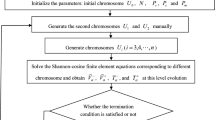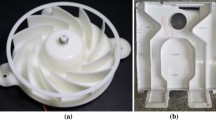Abstract
In order to optimize structure of twin screw compressor, and improve the working efficiency of twin screw refrigeration compressor, the heat transfer rules of cavity in twin screw refrigeration should be obtained correctly. Because the coupling of clearance leakage flow and heat transfer has a significant effect on heat transfer of cavity medium of twin screw refrigeration compressor, the heat transfer model of cavity medium under clearance leakage-heat coupling is constructed. To promote the computation accuracy and efficiency, the fuzzy beamlet finite element model is constructed by considering fuzzy affecting parameters and taking beamlet transform as interpolating function of element. The heat transfer laws of medium in cavity are obtained based on the theoretical an experimental analysis. Based on the simulation results, the computation error of fuzzy beamlet finite element method has least computation error and diversity than the other two methods for comparison, and the running time of fuzzy beamlet finite element method is least. Heat transfer analysis of medium in cavity under three conditions is carried out, and results show that temperature of cavity medium of twin screw refrigeration compressor is highest when the clearance leakage-heat coupling is considered and agrees better with reality; therefore, the proposed method has higher computing precision and efficiency than selected numerical methods according to computing results and running time. The impact of different clearances on heat transfer of medium in cavity is analyzed based on fuzzy beamlet finite element method, results show that the temperature of cavity medium increases accordingly as tooth top clearance, clearance between teeth, suction end clearance and exhaust end clearance increase, and the suction end clearance and exhaust end clearance have less effect on temperature of cavity medium.










Similar content being viewed by others
Abbreviations
- b :
-
beamlet in position and orientation at a certain scale
- \(B_{{{\text{n}},\updelta}}\) :
-
Collection of beamlet basis on all scales
- c p :
-
Specific heat capacity of medium in clearance (J kg−1 K−1)
- c T :
-
Specific heat capacity (J kg−1 K−1)
- \(\vec{c}\) :
-
Beamlet coefficient vector
- dl:
-
Straight line infinitesimal
- e :
-
Beamlet finite element
- f(x(l)):
-
Physical quantity function on curvilinear infinitesimal
- \(\tilde{h}_{\text{c}}\) :
-
Given convective heat transfer coefficient on third boundary condition \(\varGamma_{3}\)
- H :
-
Heat capacity matrix
- i, j :
-
x, y, and z coordinate
- k :
-
Thermal conductivity (W m−1 K−1)
- K :
-
Heat conduction matrix
- n x, n y and n z :
-
Outward cosines of first boundary condition
- p :
-
Pressure of medium in clearance of twin screw compressor (MPa)
- \(\bar{p}\) :
-
Pressure after filtering processing (MPa)
- q j :
-
Sub-grid thermal flux (J s−1)
- \(\tilde{q}_{\text{f}} (t)\) :
-
Given heat flux density on second boundary condition \(\varGamma_{2}\) (J m−2 s−1)
- \(Q = Q(x,y,z,t)\) :
-
Internal heat source of medium in cavity (W m−3)
- R :
-
Temperature load vector (K)
- S :
-
Surface of beamlet finite element (m2)
- \(\bar{S}_{\text{ij}}\) :
-
Velocity deformation rate tensor on solvable scale
- t :
-
Time (s)
- T :
-
Temperature of medium in clearance of twin screw compressor (K)
- T b(t):
-
Given temperature on first boundary condition \(\varGamma_{ 1}\) (K)
- \(\vec{u}\) :
-
Velocity vector (m s−1)
- u :
-
Velocity in the x direction (m s−1)
- \(\bar{u}_{\text{i}}\) :
-
Velocity after filtering processing in the i coordinate direction (m s−1)
- \(\bar{u}_{\text{j}}\) :
-
Velocity after filtering processing in the j coordinate direction (m s−1)
- v :
-
Velocity in the y direction (m s−1)
- V :
-
Volume of beamlet finite element (m3)
- \(\Delta V\) :
-
Sub-grid volume (m3)
- w :
-
Velocity in z direction (m s−1)
- \(\alpha\) :
-
Constraint level of each variable
- \(\rho\) :
-
Density of medium in clearance of twin screw compressor (kg m−3)
- \(\bar{\rho }\) :
-
Density of medium after filtering processing (kg m−3)
- \(\mu\) :
-
Kinetic viscosity of medium in clearance (Pa s)
- \(\lambda\) :
-
Thermal conductivity of medium in clearance (W m−1 K−1)
- \(\tau_{\text{ij}}\) :
-
Sub-grid scale stress
- Superscript “−”:
-
Lower boundary of each variable
- Superscript “+”:
-
Upper boundary of each variable
References
Wang ZL, Wang H, Qu Y, Jiang WC, Feng QK. Optimization study on multicolumn envelope meshing pair of single screw compressor based on leakage characteristics. Int J Refrig. 2018;92:113–24.
Zuo W, Li J, Zhang YT, Li QQ, Jia SY, He Z. Multi-factor impact mechanism on combustion efficiency of a hydrogen-fueled micro-cylindrical combustor. Int J Hydrog Energy. 2020;45(3):2319–30.
Sheikholeslami M. Lattice Boltzmann method simulation for MHD non-Darcy nanofluid free convection. Physica B. 2017;516:55–71.
Li QQ, Zuo W, Zhang YT, Li J, He Z. Effects of rectangular rib on exergy efficiency of a hydrogen-fueled micro combustor. Int J Hydrog Energy. 2020;45:10155–63.
Yang SM, Ouyang H, Wu YD, Wang L. Experimental study of lubricating oil impact on pressure pulsation for twin-screw refrigeration compressor. Int J Refrig. 2020;112(4):324–32.
Wang C, Xing ZW, Chen WQ, Sun SZ, He ZL. Analysis of the leakage in a water-lubricated twin-screw air compressor. Appl Therm Eng. 2019;155(6):217–25.
Pronin VA, Malyshev AA, Dolgovskaya OV. Calculation of leakages of compressed media in screw compressors. Chem Pet Eng. 2018;54(3–4):183–7.
Byeon SS, Lee JY, Kim YJ. Performance characteristics of a 46 oil-free twin-screw compressor. Energies. 2017;10(7):945–61.
Pereira ELL, Deschamps CJ. A heat transfer correlation for the suction and compression chambers of scroll compressors. Int J Refrig. 2017;82(10):325–34.
Sandeep PN, Chandrakant LP, Narayan KS. Effect of novel flow divider type turbulators on fluid flow and heat transfer. Therm Sci Eng Prog. 2019;3:322–31.
Afaque S, Andrea DS. Towards the accurate prediction of the turbulent flow and heat transfer in low-Prandtl fluids. Int J Heat Mass Transf. 2019;130(3):290–303.
Azdoud Y, Cheng JH, Ghosh S. Wavelet-enriched adaptive crystal plasticity finite element model for polycrystalline microstructures. Comput Method Appl Mech Eng. 2017;327(12):36–57.
Mirparizi M, Fotuhi AR, Shariyat M. Nonlinear coupled thermoelastic analysis of thermal wave propagation in a functionally graded finite solid undergoing finite strain. J Therm Anal Calorim. 2020;139:2309–20.
Shashank V, Arun CO. A stochastic B-spline wavelet on the interval finite element method for problems in elasto-statics. Probab Eng Mech. 2019;58(10):102996.
Ali M, Hamid RM, Mostafa G. Wavelet-based spectral finite element dynamic analysis for an axially moving Timoshenko beam. Mech Syst Signal Process. 2017;92(8):124–45.
Shahin G, Asghar M, Azim K, Ali RF. Dosimetric evaluation of small IMRT beamlets in the presence of bone inhomogeneity using NIPAM polymer gel and Monte Carlo simulation. Radiat Meas. 2017;105(10):62–9.
Khodaparast HH, Govers Y, Dayyani I, Adhikari S, Link M, Friswell MI, Mottershead JE, Sienz J. Fuzzy finite element model updating of the DLR AIRMOD test structure. Appl Math Model. 2017;52(12):512–26.
Patle BK, Chetan KH, Ravi PS, Subrata KP. Eigenfrequency and deflection analysis of layered structure using uncertain elastic properties—a fuzzy finite element approach. Int J Approx Reason. 2018;98(7):163–76.
Farizhandi AAK, Zhao H, Chen T, Lau R. Evaluation of material properties using planetary ball milling for modeling the change of particle size distribution in a gas–solid fluidized bed using a hybrid artificial neural network-genetic algorithm approach. Chem Eng Sci. 2020;215(4):115469.
Manjunatha G, Rajashekhar C, Vaidya H. Impact of heat and mass transfer on the peristaltic mechanism of Jeffery fluid in a non-uniform porous channel with variable viscosity and thermal conductivity. J Therm Anal Calorim. 2020;139(2):1213–28.
Ferhi M, Djebali R, Abboudi S. Conjugate natural heat transfer scrutiny in differentially heated cavity partitioned with a conducting solid using the lattice Boltzmann method. J Therm Anal Calorim. 2019;138(5):3065–88.
Hemmat EM, Saedodin S, Hasani ME. Mixed convection inside lid-driven cavities filled with nanofluids. J Therm Anal Calorim. 2019;135(1):813–59.
Shi Jun, Wang Yueling. Estimation of muscle pennation angle in ultrasound images using the beamlet transform. J Shanghai Univ (English Edition). 2010;1:34–8.
Yuvaraj R, Senthil KD. Numerical simulation of thermal wave propagation and collision in thin film using finite element solution. J Therm Anal Calorim. 2020. https://doi.org/10.1007/s10973-020-09346-y.
Acknowledgements
The research is supported by “Scientific Research Funding Project form the Educational Department of Liaoning Province (L2019022).”
Author information
Authors and Affiliations
Corresponding author
Additional information
Publisher's Note
Springer Nature remains neutral with regard to jurisdictional claims in published maps and institutional affiliations.
Rights and permissions
About this article
Cite this article
Zhao, B., Chen, H., Gao, D. et al. Heat transfer simulation in cavity of twin screw compressor under coupling of clearance leakage-heat by utilizing fuzzy beamlet finite element model. J Therm Anal Calorim 143, 3221–3232 (2021). https://doi.org/10.1007/s10973-020-09531-z
Received:
Accepted:
Published:
Issue Date:
DOI: https://doi.org/10.1007/s10973-020-09531-z




